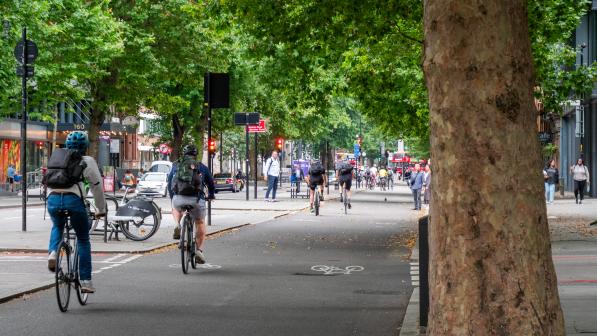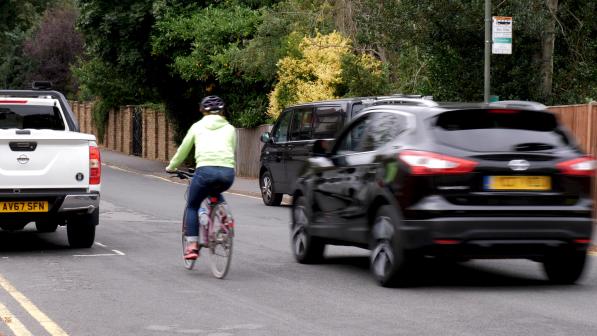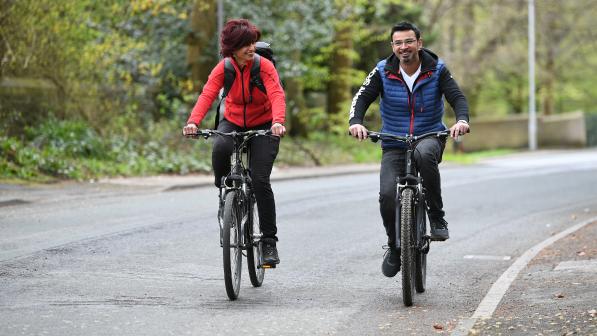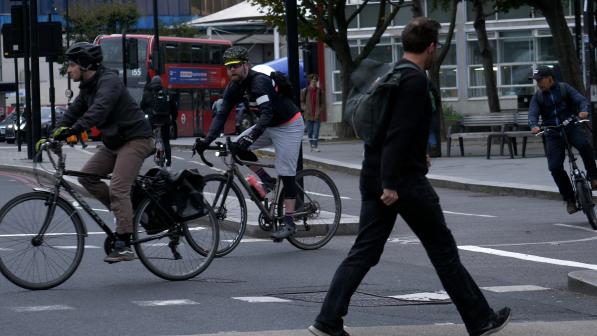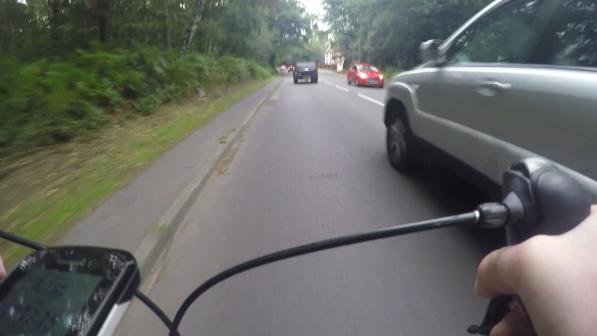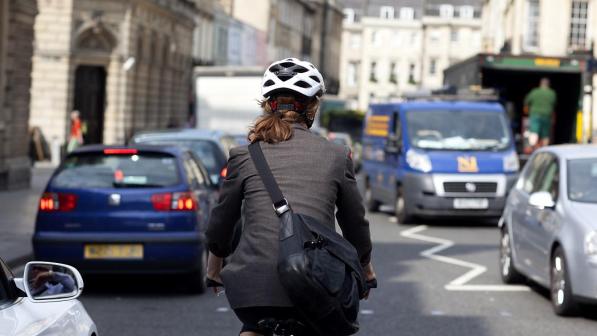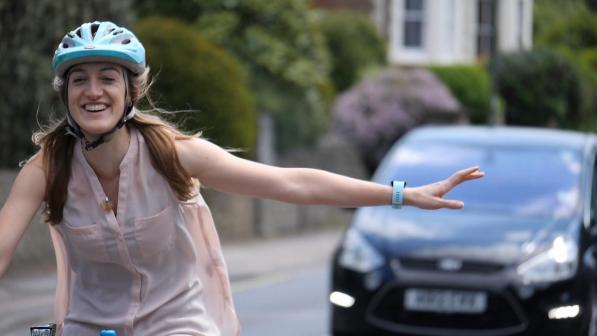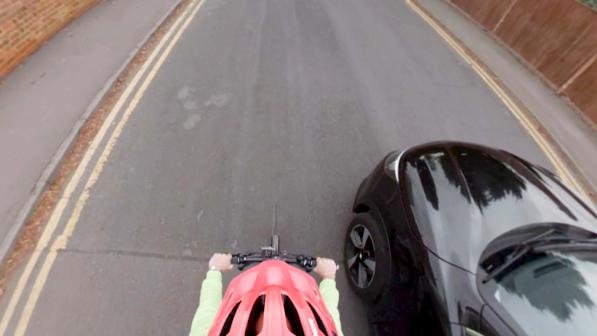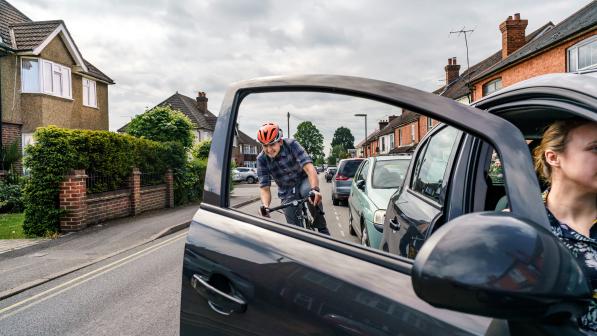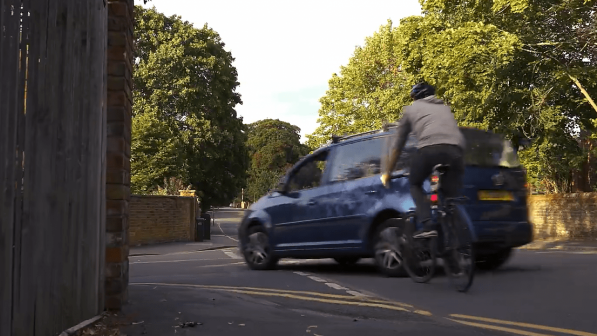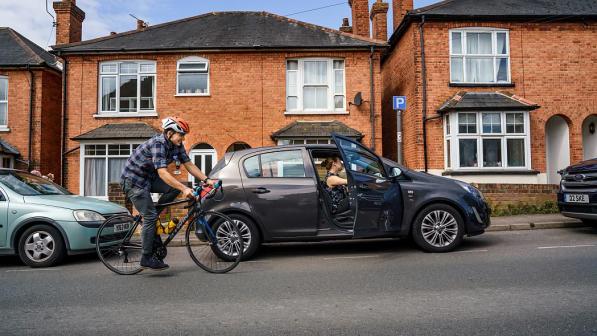Changes to the Highway Code: FAQs

Where does the new Highway Code apply?
What are the main changes for cyclists and pedestrians?
Why has the Highway Code changed and who agreed the changes?
When do the changes take effect?
What is the Highway Code’s status in law?
Ten key changes
1. A 'Hierarchy of Road Users' (Introduction / Rule H1)
2. Junction priority (Rules H2, H3)
3. Dangerous overtaking and ‘close passes’ (Rule 163)
4. The ‘Dutch Reach’ (Rule 239)
5. Group riding (Rule 66)
6. Road positioning (Rules 72 & 213)
7. Cycle lanes and cycle tracks (Rule 140)
8. Slow-moving traffic (Rule 151)
9. Advanced stop lines (Rule 178)
10. Roundabouts (Rule 186)
Where does the new Highway Code apply?
The Highway Code applies in England, Scotland and Wales.
Northern Ireland’s separate code tends to follow the GB version, and we understand that a review is on the way.
What are the main changes for cyclists and pedestrians?
The code’s newly stated aim is to: “… promote safety on the road, whilst also supporting a healthy, sustainable and efficient transport system.”
Several welcome changes have been introduced to help make cyclists and pedestrians (especially children, older adults and disabled people) feel and be safer on the roads. We highlight ten of the changes below.
Why has the Highway Code changed and who agreed the changes?
The Highway Code has to reflect changes in the law, new infrastructure design and the way people use the roads, so it’s been reviewed and revised several times since it first appeared in 1931.
The Department for Transport consulted on the latest changes in 2020 and, following analysis of the feedback, revisions were laid before Parliament on 1 December 2021.
When do the changes take effect?
29 January 2022.
What is the Highway Code’s status in law?
Many rules in the code are legal requirements, so disobeying them is a criminal offence. If the code says you ‘MUST/MUST NOT’ do something, it means it’s the law.
If the code says you ‘should/should not’ do something (or ‘do/do not’), failing to comply is not in itself against the law, but non-compliance could still make a difference to the outcome of a criminal or civil court case.
None of the changes covered below introduces new ‘MUST/MUST NOT’ rules.
Ten key changes
Cycling UK campaigned particularly on the following rules, so the following FAQs focus on them:
- A 'Hierarchy of Road Users' (Introduction / Rule H1)
- Junction priority (Rules H2, H3)
- Dangerous overtaking and ‘close passes’ (Rule 163)
- The 'Dutch Reach', to help prevent ‘car-dooring’ (Rule 239)
- Group riding (Rule 66)
- Road positioning (Rules 72 / 213)
- Cycle lanes and cycle tracks (Rule 140)
- Crossing in front of drivers in slow moving traffic (Rule 151)
- Advanced Stop Lines (Rule 178)
- Cyclists at roundabouts (Rule 186)
1. A 'Hierarchy of Road Users' (Introduction / Rule H1)
What’s the new rule?
The code introduces the concept of the ‘Hierarchy of Road Users’. It explains this as a:
- “… concept which places those road users most at risk in the event of a collision at the top of the hierarchy.”
Those most likely to be injured in collisions, and therefore at the top of the hierarchy, are:
- “… pedestrians, cyclists, horse riders and motorcyclists, with children, older adults and disabled people being more at risk.”
It follows that:
- “… those in charge of vehicles that can cause the greatest harm in the event of a collision bear the greatest responsibility to take care and reduce the danger they pose to others. This principle applies most strongly to drivers of large goods and passenger vehicles, vans/minibuses, cars/taxis and motorcycles.”
The rule also states:
- “Cyclists, horse riders and drivers of horse drawn vehicles likewise have a responsibility to reduce danger to pedestrians.”
And reminds all road users that:
- “… the people you encounter may have impaired sight, hearing or mobility and that this may not be obvious.”
What’s behind these changes?
It is a statistical fact that pedestrians, cyclists, horse riders and motorcyclists are more likely to be hurt in collisions with motor vehicles than the drivers involved.
To help protect vulnerable road users like this, and especially children, older adults and people with disabilities, the code now explicitly expects drivers of motor vehicles to exercise a greater degree of responsibility (many, of course, do this naturally already).
What the rule doesn’t do
The rules make it clear that greater power brings greater responsibility, but do not detract from the responsibility of all road users, including people on foot, bike or horse, to:
- “… have regard for their own and other road users’ safety”
Further reading
- Why we need a hierarchy of responsibility in the Highway Code (Cycling UK 4 August 2020).
2. Junction priority (Rules H2, H3)
What are the new rules?
Rule H2 is linked to the hierarchy covered above and explains priority in practice. This includes expecting riders and drivers at junctions to give way:
- “…to pedestrians crossing or waiting to cross a road into which or from which you are turning.”
- “… to pedestrians waiting to cross a zebra crossing, and to pedestrians and cyclists waiting to cross a parallel crossing.”
Rule H3, also linked to the hierarchy, includes the following advice for drivers and motorcyclists:
- “You should not cut across cyclists, horse riders or horse drawn vehicles going ahead when you are turning into or out of a junction or changing direction or lane, just as you would not turn across the path of another motor vehicle. This applies whether they are using a cycle lane, a cycle track, or riding ahead on the road and you should give way to them.
- “Do not turn at a junction if to do so would cause the cyclist, horse rider or horse drawn vehicle going straight ahead to stop or swerve.”
What’s behind these changes?
Junctions are risky and sometimes intimidating and confusing places, especially for vulnerable road users, so everyone needs to be clear about what to do if there are no signals.
The new code protects pedestrians and cyclists better from collisions (e.g. ‘left hooks’) and near misses because it gives them priority not only once they’ve started to cross, but while they’re waiting to cross too.
This also means that cyclists turning left have to give way to pedestrians waiting or already crossing a side road.
The new rule will also help protect people on a bike or horse (or in a horse-drawn vehicle) from drivers whose junction manoeuvres could cause them to stop or swerve, both of which are potential hazards.
Further reading/watching
- Highway Code proposals: a simple rule for junctions (Cycling UK 11 August 2020)
- Video explaining why the changes are so important (Cycling UK)
3. Dangerous overtaking and ‘close passes’ (Rule 163)
What’s the new rule?
Much of Rule 163 is the same, but it’s been expanded. It now includes clearer guidance on how much room drivers should give cyclists and other vulnerable road users when overtaking:
“─ leave at least 1.5 metres when overtaking cyclists at speeds of up to 30mph, and give them more space when overtaking at higher speeds”
“─ take extra care and give more space when overtaking motorcyclists, cyclists, horse riders, horse drawn vehicles and pedestrians in bad weather (including high winds) and at night”
“─ you should wait behind the motorcyclist, cyclist, horse rider, horse drawn vehicle or pedestrian and not overtake if it is unsafe or not possible to meet these clearances”
What’s behind these changes?
When you’re on your bike, motor vehicles who pass you too closely may hit you or, even if they don’t, cause you to swerve and/or topple. Even if you manage to stay upright, close passes can be extremely scary.
While many drivers are well aware of this and overtake considerately, some don’t – either from lack of care or because they simply don’t know how much space people on bikes need.
Up till now, the code didn’t help much, but the new version is clearer about safe passing distances and, moreover, when to wait behind. This is useful information for drivers, and should help improve the experience of existing cyclists and make the roads less daunting for novices.
Further reading
- Cycling UK’s Too Close for Comfort campaign
4. The ‘Dutch Reach’ (Rule 239)
What's the new rule?
Rule 239 now incorporates advice for drivers and passengers on how to open their doors to reduce the likelihood of ‘car dooring’ anyone:
- “where you are able to do so, you should open the door using your hand on the opposite side to the door you are opening; for example, use your left hand to open a door on your right-hand side. This will make you turn your head to look over your shoulder. You are then more likely to avoid causing injury to cyclists or motorcyclists passing you on the road, or to people on the pavement”
This technique is commonly known as the ‘Dutch Reach’.
The new version now also mentions “looking all around and using your mirrors”.
What’s behind these changes?
The existing rule already explained that you MUST ensure you do not hit anyone when you open your vehicle door (it’s been a criminal offence for years), but the additional advice on how to avoid it should help make it less likely.
The majority of victims of car dooring are cyclists (typically thrown into the road and run over by another vehicle).
Further reading/watching
- Why we need the Dutch Reach in the Highway Code (Cycling UK, 18 August 2020)
- Cycling UK’s video explaining the Dutch Reach
5. Group riding (Rule 66)
What's the new rule?
The main change to Rule 66 relates to the ‘should’ advice on riding more than two abreast.
The new wording says:
- “be considerate of the needs of other road users when riding in groups. You can ride two abreast and it can be safer to do so, particularly in larger groups or when accompanying children or less experienced riders. Be aware of drivers behind you and allow them to overtake (for example, by moving into single file or stopping) when you feel it is safe to let them do so”
Rule 66 also makes a few slight changes to the wording about keeping in control of your bike, and also refers to “calling out” to alert others to your presence (previously, it only mentioned bells).
What’s behind these changes?
Anyone who’s ever ridden in a group will know that it’s not always safe to pull in and ride in single file to allow drivers to overtake. Riding two abreast may be done, for instance, to help protect young or less experienced riders, on narrow or busy roads, or when riding round bends.
In other words, riding two abreast – which is perfectly legal – may be the safer option for everyone for some sections of a ride. Dangerous overtaking is in no-one’s interests.
Unfortunately, the code’s old wording was often misquoted to suggest that cyclists either shouldn’t be riding two abreast or had to single out to allow drivers to overtake.
By explaining why cyclists may choose to ride two abreast, the new code should help dispel common misunderstandings (although we feel that the wording we proposed would have made the situation clearer – for more, see further reading below).
Rule 213 also refers to riding two abreast (see below).
Further reading
- Why the Highway Code should protect riding two abreast (Cycling UK, 16 October 2020)
- A new Highway Code and a hierarchy (Cycling UK, 1 December 2021). This explains our reservations about the changes to this rule.
6. Road positioning (Rules 72 & 213)
What are the new rules?
Rules 72 and 213 complement each other. Rule 72 explains safe road positioning to cyclists, and 213 explains to other road users why cyclists, who are following the guidance set out in 72, adopt certain positions on the road to keep themselves safe.
New rule 72 explains to cyclists:
- “When riding on the roads, there are two basic road positions you should adopt, depending on the situation.
- 1. Ride in the centre of your lane, to make yourself as clearly visible as possible, in the following situations:
- on quiet roads or streets – if a faster vehicle comes up behind you, move to the left to enable them to overtake, if you can do so safely
- in slower-moving traffic – when the traffic around you starts to flow more freely, move over to the left if you can do so safely so that faster vehicles behind you can overtake
- at the approach to junctions or road narrowings where it would be unsafe for drivers to overtake you
- 2. When riding on busy roads, with vehicles moving faster than you, allow them to overtake where it is safe to do so whilst keeping at least 0.5 metres away, and further where it is safer, from the kerb edge. Remember that traffic on most dual carriageways moves quickly. Take extra care crossing slip roads.”
Revised rule 213, which appears in the section ‘Road users requiring extra care’, says:
- “On narrow sections of road, on quiet roads or streets, at road junctions and in slower-moving traffic, cyclists may sometimes ride in the centre of the lane, rather than towards the side of the road. It can be safer for groups of cyclists to ride two abreast in these situations. Allow them to do so for their own safety, to ensure they can see and be seen. Cyclists are also advised to ride at least a door’s width or 1 metre from parked cars for their own safety.
- “Motorcyclists, cyclists, horse riders and horse drawn vehicles may suddenly need to avoid uneven road surfaces and obstacles such as drain covers or oily, wet or icy patches on the road. Give them plenty of room and pay particular attention to any sudden change of direction they may have to make.”
(The second paragraph is the same as before, except for the addition of horse riders and horse drawn vehicles).
What's behind these changes?
On quiet roads and in slow-moving traffic when no drivers need to overtake, as well as on narrow or bendy sections of road or when approaching junctions, riding in the middle of the lane helps make cyclists more visible to drivers, and reduces the likelihood of being cut up or overtaken dangerously.
Also, cyclists are best advised to give parked cars a wide berth (i.e. to avoid carelessly opened car doors which can hit them – see Rule 239). Equally, cyclists may often need to ride out into the road to skirt round potholes, drain covers, or slippery surfaces etc. to avoid being thrown from their bikes.
This advice is not new – in fact, it’s at least 16 years’ old. It’s what millions of school children and adults have and are still being taught to do, thanks to the Government-backed ‘National Standard for Cycle Training’ which replaced the old ‘Cycle Proficiency’ scheme from 2005. (It’s branded as ‘Bikeability’ in England).
It’s high time, therefore, for this guidance, based on wide expertise and experience, to be incorporated into the Highway Code.
What these rules don’t do
Clearly, this rule does not advise cyclists to ride in the centre of the road, nor is it about obstructing others for no good reason. It simply advises cyclists to stay safe by riding in the centre of their lane in some situations.
Further reading
- Why new rules on road positioning will make the Highway Code safer (Cycling UK, 26 August 2020)
- National Standard for Cycle Training (DfT/DVSA, 2018)
- Graphic from Cycling UK (Twitter)
7. Cycle lanes and cycle tracks (Rule 140)
What's the new rule?
Rule 140 is not so much a change as clarification of the rules on cycle lanes, and makes it clear that they apply to cycle tracks too. It also links up specifically with the newly introduced ‘Hierarchy of Road Users’ (see above).
After repeating the existing ‘MUST NOT’ rules on driving or parking in cycle lanes (mandatory and advisory), the updated rule adds:
- “You should give way to any cyclists in a cycle lane, including when they are approaching from behind you – do not cut across them when you are turning or when you are changing lane (see Rule H3). Be prepared to stop and wait for a safe gap in the flow of cyclists before crossing the cycle lane.
- “Cycle tracks are routes for cyclists that are physically protected or located away from motor traffic, other than where they cross side roads. Cycle tracks may be shared with pedestrians.
- “You should give way to cyclists approaching or using the cycle track when you are turning into or out of a junction (see Rule H3). Be prepared to stop and wait for a safe gap in the flow of cyclists before crossing the cycle track, which may be used by cyclists travelling in both directions.
- “Bear in mind that cyclists are not obliged to use cycle lanes or cycle tracks.”
What’s behind these changes?
This rule’s more expansive information about cycle lanes and cycle tracks should help everyone understand exactly what to do when they encounter them.
Importantly, it reminds road users that whether to use them is up to individual cyclists – contrary to common belief, there are no laws forcing cyclists to use cycle lanes/tracks. (Dedicated infrastructure doesn’t necessarily suit all cyclists or their particular journey, and some may feel safer on the carriageway – e.g. if the facility is too narrow, poorly maintained etc.)
8. Slow-moving traffic (Rule 151)
What's the new rule?
A small, but crucial, addition to Rule 151 advises drivers and riders to:
- “allow pedestrians and cyclists to cross in front of you”
The rule otherwise stays the same.
What’s behind this change?
In slow-moving traffic, it is often more efficient for cyclists to filter past other traffic. This rule now makes it clear that this is permitted.
Further reading
- National Standard for Cycle Training (DfT/DVSA, 2018)
9. Advanced stop lines (Rule 178)
What's the new rule?
This rule is the same, except for more detail for drivers on what to do at Advanced Stop Lines (ASLs).
It now says (changes in bold):
- “If your vehicle has proceeded over the first white line at the time that the signal goes red, you should stop as soon as possible and MUST stop at the second white line. Allow cyclists, including any moving or waiting alongside you, enough time and space to move off when the green signal shows.”
The rule also adds:
- “Drivers of large vehicles should stop sufficiently far behind the first white line so that they can see the whole area where cyclists may be waiting, allowing for any blind spot in front of the vehicle.”
What’s behind this change?
By giving cyclists a head start, ASLs are designed to help them negotiate signalised junctions safely, especially busy ones. It’s important that everyone knows exactly how they are meant to operate.
Advising drivers to stop as soon as possible if they’ve crossed the first white line when the signal’s turned red is a safer arrangement than if they proceed straight to the second line and occupy the ASL box. Also, it’s not just cyclists in front who need enough time and space to move off at green – cyclists moving or waiting alongside need that too.
All drivers need to be aware of and be able to see cyclists waiting at these junctions, but this is particularly important for those in charge of large vehicles (e.g. HGVs). They may have a restricted view because of the way their cabs are designed.
10. Roundabouts (Rule 186)
What's the new rule?
Two new paragraphs have been added to this rule:
- “You should give priority to cyclists on the roundabout. They will be travelling more slowly than motorised traffic. Give them plenty of room and do not attempt to overtake them within their lane. Allow them to move across your path as they travel around the roundabout.”
- “Cyclists, horse riders and horse drawn vehicles may stay in the left-hand lane when they intend to continue across or around the roundabout and should signal right to show you they are not leaving the roundabout. Drivers should take extra care when entering a roundabout to ensure that they do not cut across cyclists, horse riders or horse drawn vehicles in the left-hand lane, who are continuing around the roundabout.”
What’s behind this change?
Expecting drivers to give cyclists priority at roundabouts will help make them safer places, as will the advice on giving them plenty of room and not overtaking within their lane.
Also, pointing out that confident and not-so confident riders may take different approaches to negotiating a roundabout should help increase and underpin drivers’ understanding.
